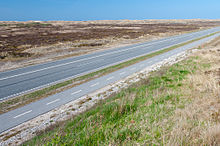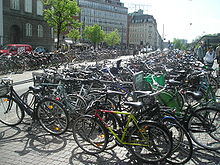- Cycling in Denmark
-
 The bicycle path between Skagen and Frederikshavn is very popular with tourists. Here it runs parallel with (but clearly separated from) the road - at other places it goes through forest and dune areas.
The bicycle path between Skagen and Frederikshavn is very popular with tourists. Here it runs parallel with (but clearly separated from) the road - at other places it goes through forest and dune areas.
Cycling is a common and popular recreational and utilitarian activity in Denmark. Bicycling infrastructure is a dominant feature of both city and countryside infrastructure with segregated dedicated bicycle paths and lanes in many places and an extensive network of bicycle routes extending more than 12,000 kilometres (7,500 mi) nationwide[1] (in comparison Denmark's coastline is 7,314 kilometres (4,545 mi)). Often bicycling and bicycle-culture in Denmark is compared to the Netherlands as a bicycle-nation.
Contents
Infrastructure
Bicycle paths and lanes
There are an estimated 7,000 kilometres (4,300 mi)[2] of segregated dedicated bicycle paths and lanes in Denmark and the four biggest cities alone account for more than 1,350 kilometres (840 mi) with 609 kilometres (378 mi) in Aalborg, 510 kilometres (320 mi) in Odense,[3] 450 kilometres (280 mi) in Aarhus[4] and 412 kilometres (256 mi) in Copenhagen.[5]
Bicycle paths are often raised above the shoulder of the road and separated by a curb,[6] but on older roads it is more common to have a bicycle lane separated by a thick white line and sometimes the lane may be marked by coloured asphalt. Massive infrastructure investments are taking place to create more bicycle ways and thus increase safety. At intersections, the continuation of the bicycle way or lane is often highlighted by a broad blue band to increase its visibility and cyclists may find that they have their own set of traffic lights.[6] In general both paths and lanes are designed for the more slow pace of utility bicycling as opposed to more speedy designs in other countries. The Danish Roads Directorate acknowledges that the Danish cycle track system "functions best when cyclists travel at relatively low speeds".[7]
In Copenhagen a system of interconnected green bicycle routes, "greenways", is under development, with the aim of facilitating fast, safe and pleasant bicycle transport across the city. The network will cover more than 100 kilometres (62 mi) and consist of 22 routes. As of 2011, there were 40 kilometres (25 mi) of greenways in Copenhagen.[8]
Integration with other means of transportation
Bicycling is integrated into both the national, the regional and the local train services in Denmark. Bicycles are permitted on trains to facilitate mixed-mode commuting. This is most visible in the urban and suburban rail network of Metropolitan Copenhagen, the S-trains, where bicycles can be transported in specified carriages found at the front and rear of each train. As of 2011 there is no charge for taking bicycles on any S-train.[9] In general public transport bus services in Denmark do not permit the carriage of bicycles, but the Copenhagen Harbour Buses are an exception and allow for up to four bicycles to be carried.
Cycle parking
Although there are appear to be a large number of bicycle parking facilities in Denmark there is actually a severe lack of available bicycle stands and those that do exist are often poorly positioned, particularly in the bigger cities. In 2008, with a view to remedying the situation, the Danish Cyclists Federation published a Bicycle Parking Manual with a number of guidelines. They aim to be of immediate practical use to users but also offer advice for city planners wishing to improve facilities in the future.[10]
Utility cycling
Most children start bicycling to school from age 8-10 and continue to do so until at least 18 (the minimum age for acquiring a drivers license in Denmark), but in the bigger cities some people will rely on the bicycle as the primary transportation throughout life. Most Danish public schools also educates 10–12 years in traffic rules, behaviour and regulations as a part of their regular curriculum.[11] Utility bicycles which require little maintenance and are suited to load carrying are very popular. However, all other types of bicycles are accommodated on the bicycle paths/ways, from racing bicycles with tri-bars through streamlined velomobiles. Two- and three-wheeled cargo bicycles are also becoming increasingly popular, with the trend starting in Copenhagen and spreading out through the country.
The common use of bicycles and the growing support infrastructure for utility bicycling, has encouraged Denmark to brand itself as a leading nation in everyday bicycling.[12] It has also led to the reinvention of the term Copenhagenization as a concept in urban planning and design relating to the implementation of better pedestrian facilities and segregated bicycle facilities for utility cycling in cities,[13] and been an inspiration for an increasing number of cycle chic blogs spawning from Copenhagen Cycle Chic.[14]
Danish postal workers have been using bicycles for transport in towns and cities to deliver mail and light for several generations. Likewise small shop delivery services used bicycles at the turn to the last century and up until mid 60's, where the majority of shopping was moved to supermarkets. As a result of that delivery by bicycles declined, though the messenger services sparked new life for delivery by bike in the mid 80's.
Since the mid 2000s bicycle rickshaws and velo taxis have operated in the bigger cities [15][16] and offer short distance journeys (usually up to 3 kilometres (1.9 mi)) - primarily during summer. Around the same period small enterprises started selling coffee or soup from mobile tricycle stalls around city centres.
Since March 1, 2009 the police in Copenhagen have been patrolling on bicycles. Besides being a quick and efficient means of transportation, it has been found to increase visibility and to improve contact with citizens.[17]
Danish bicycle VIN-system
The Danish bicycle VIN-system is a system introduced in 1942 by the Danish government, providing all bicycles in Denmark with a unique code. The code is a combination of letters and digits embedded into the bicycle frame and made up of a manufacturer-code, a serial-number and construction year. By law it has been illegal since 1948 to sell bicycle frames in Denmark without an embedded VIN and, as a result, insurance companies in Denmark do not pay indemnities for stolen bicycles without a VIN.[18]
Regular bicycle events in Denmark
- Danmark Rundt, a national Danish stage race since 1985, usually held in late July or early August
- A yearly 6 day track race, usually held in Ballerup in late January or early February since 1934[19]
- Rundetårn Unicycle Race, every year in spring, a unicycle race is held in the tower's 7.5-turn helical corridor. The contestants have to go up and down the Rundetårn. The world record, set in 1988, is 1 minute and 48.7 seconds.[20]
Tourists
It is quite common in Denmark to rent a bicycle for riding around the countryside or the city. Most cities have a form of a bicycle sharing system. The method and pricing varies from location to location: the Copenhagen City Bikes in Copenhagen, for example, require a deposit of 20DKR and restrict the use of the bicycle to a defined area in the city centre, whereas other companies require documentation and a higher deposit. Bycykel in Aalborg is like in Copenhagen, for 20DKR and the you can drive around in the city. Bicycle rental shops are quite common and a many different types of bicycles are available. In Denmark, as with other countries where bicycling is popular, like the Netherlands, bicycle helmets are hardly ever worn. A parliamentary proposal in 2009 to introduce a mandatory helmet law for children in Denmark was defeated.[21]
Cars and bicycles
In general bicycles and cars coexist quite well in Denmark and, unlike the Netherlands, Denmark does not have strict liability for car-drivers, but instead has a system that partially resembles it. There are two forms of liability that comes into action: liability in regards to the Danish traffic law (Danish: Færdselsloven) and liability in damages in regards to the insurance companies. In an accident where a car going the right way in a one-way street and hits a cyclist going the wrong way, there will be a liability for both the car's owner (who will not necessarily be the driver) and the bicyclist. This is due to a requirement for liability insurance (Danish: ansvarsforsikring) for vehicle owners;[22] the insurance companies will always apply this and thus make the vehicle's owner liable for damages. However the cyclist may be deemed liable by the Danish legal system for violating the one-way restriction while the driver may escape charges. In that case the car owner's insurance company may seek reimbursement (Danish: regres) from the cyclist. However in the majority of the accidents the car driver is found liable in both regards; in 1999, in 90% of the accidents involving cars and bicyclists the car-drivers were found fully liable.[23]
See also
- Danish Cycling Federation
- Danish Cyclists Federation
- Cycling Embassy of Denmark
- Cycling in Copenhagen
References
- ^ "Cykelruter og regioner" (in Danish). VisitDenmark. http://www.visitdenmark.dk/danmark/da-dk/menu/turist/inspiration/aktivferie/cykel/cykel-ruter-og-regioner.htm. Retrieved 2011-08-16.
- ^ "Vi cykler til arbejde 2011" (in Danish). Dansk Cyklist Forbund. http://www.vcta.dk/OmVCTA.aspx. Retrieved 2011-08-16.
- ^ "Odense Kommune: Cykelstier" (in Danish). The municipality of Odense. http://www.odense.dk/web4/cyklisternesby/service/cykelstier.aspx. Retrieved 2011-08-16.
- ^ "Århus Cykelby / Cykelstier og -ruter" (in Danish). The municipality of Aarhus. http://www.aarhuscykelby.dk/StandardPage.asp?PgID=52. Retrieved 2011-08-16.
- ^ "Cykelstier og -baner" (in Danish). The municipality of Copenhagen. http://www.kk.dk/Borger/ByOgTrafik/CyklernesBy/KonkreteProjekter/OevrigeProjekter/Cykelstier.aspx. Retrieved 2011-08-16.
- ^ a b "Engineering and Design Elements". Pedestrian and Bicyclist Safety and Mobility in Europe. Federal Highway Administration (US Dept. of Transportation). November 18, 2010. http://www.international.fhwa.dot.gov/pubs/pl10010/ch03.cfm. Retrieved August 18, 2011.
- ^ "Collection of Cycle Concepts". The Danish Road Directorate. 2000. http://www.vejdirektoratet.dk/publikationer.asp?page=document&objno=17291. Retrieved 2011-08-19.
- ^ "Grønne Cykelruter" (in Danish). The municipality of Copenhagen. 2011-06-24. http://www.kk.dk/Borger/ByOgTrafik/CyklernesBy/KonkreteProjekter/OevrigeProjekter/GroenneCykelruter.aspx. Retrieved 2011-08-19.
- ^ "Tag cyklen med i toget kvit og frit" (in Danish). dsb.dk. http://www.dsb.dk/s-tog/kampagner/s-tog-og-cykler/. Retrieved August 18, 2011.
- ^ "Bicycle Parking Manual" (PDF). Dansk Cyklist Forbund. 2008. http://www.celis.dk/Bicycle_Parking_Manual_Screenversion.pdf. Retrieved 2011-08-16.
- ^ "Education Elements". Pedestrian and Bicyclist Safety and Mobility in Europe. Federal Highway Administration (US Dept. of Transportation). November 18, 2010. http://www.international.fhwa.dot.gov/pubs/pl10010/ch04.cfm. Retrieved August 18, 2011.
- ^ "Danish Spaces". Denmark.dk: The official website of Denmark. 2011-05-10. http://www.denmark.dk/en/servicemenu/media-room/DanishSpaces/. Retrieved 2011-08-16.
- ^ Henriette Jacobsen (2009-12-14). "Bicycle-friendly Copenhagen a model for big cities". reuters.com. Reuters. http://www.reuters.com/article/idUSTRE5BD2GK20091214. Retrieved 2010-01-11.
- ^ "Cycle Chic - the original from Copenhagen". Copenhagenize Consulting. http://copenhagencyclechic.com/. Retrieved 2011-08-19.
- ^ "Gennem byen på miljøvenlige hjul". AOK. http://www.aok.dk/byen-rundt/guide/gennem-byen-paa-miljoevenlige-hjul. Retrieved 2009-10-30.
- ^ "Snup en cykeltaxi til kunstens verden" (in Danish). Lokalavisen Aarhus. 2011-08-03. http://www.aarhusportalen.dk/vis_artikel.asp?ArticleId=30282. Retrieved 2011-08-22.
- ^ "Betjente på jernhest er en succes". Jyllands Posten. http://jp.dk/indland/kbh/article1842963.ece. Retrieved 2009-10-30.
- ^ Lund, Preben (2011-06-12). "Demand for marking of stolen goods" (in Danish). DR Nyheder. http://www.dr.dk/Nyheder/Indland/2011/06/12/010459.htm. Retrieved 2011-06-18.
- ^ "6-dages løbets historie". http://www.6-dages.dk/historie/. Retrieved 2011-08-30.
- ^ "Sære måder at bestige tårnet på". Rundetårn. http://www.rundetaarn.dk/dansk/bagsiden/koersel.html. Retrieved 2009-08-18.
- ^ Henry, Tom (June 22, 2009). "Danish call for helmet law thrown out". road.cc. http://road.cc/content/news/5046-danish-call-helmet-law-thrown-out. Retrieved August 18, 2011.
- ^ "Færdselsloven" (in Danish). 2009-10-05. https://www.retsinformation.dk/forms/r0710.aspx?id=133981. Retrieved 2011-08-16. §105
- ^ "Cyklister uden færdselsmoral" (in Danish). Dansk Cyklist Forbund. http://93.176.77.170:8080/tema/mig_og_de_andre/cyklister_uden_moral.html. Retrieved 2011-08-16.
Categories:- Transport in Denmark
- Urban planning in Denmark
- Cycling in Denmark
Wikimedia Foundation. 2010.




